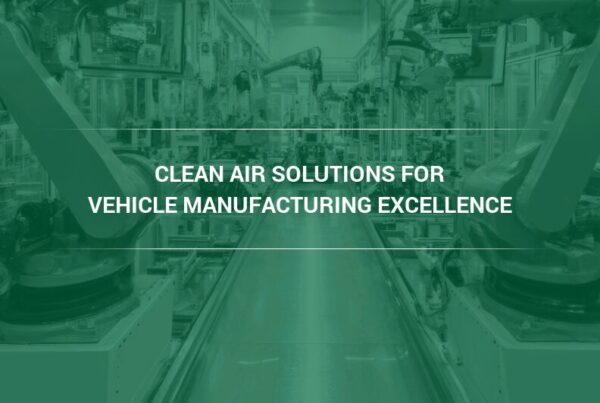This winter and early spring, it is especially important to reduce risk factors for spreading infections, including SARS-CoV-2, the virus responsible for COVID-19 infections. As many places across the United States move towards reopening, ensuring that we do so safely is essential. In this article, air filtration and HVAC experts from Camfil explain what steps we should be taking in public buildings to limit the spread of harmful pathogens this winter.
Why Does Cold Weather Increase Infection Risks?
While it’s not the cold weather itself that makes more people sick in the winter, there are several reasons why we’re more susceptible to catching colds, flu, and other infections during the colder months of the year.
- Some viruses and bacteria reproduce more effectively when the temperature is cooler.
- When the body is concerned with maintaining its internal temperature, the immune system may be less effective at combating pathogens.
- People are likely to spend more time in confined indoor spaces when the weather is colder, which increases the likelihood of encountering pathogens in the air.
How Do Infectious Particles Spread In the Air?
There are several variables that affect the possibility we’ll encounter infectious particles while indoors.
How Large are the Particles We Exhale?
Particles of different sizes and mass remain airborne for different lengths of time. While under debate due to extensive COVID research, it is generally understood that particles exhaled with a diameter of less than 5 micrometers (µm), or less than half the size of a grain of pollen, are classified as aerosols. Aerosols remain in the air for longer due to their small mass and spread more easily. Particles we exhale that are greater than 5µm in diameter are called respiratory droplets. Research has shown that 5-micrometer droplets fall 1mm per second and larger 100-micrometer droplets fall at 30cm per second. According to Jakob Löndahl, Associate Professor in Aerosol Science at Lund University in Sweden, even these large 100-micrometer droplets can travel a good distance in the air before they settle on a surface.
Infection Route
Droplet infection, which is when we inhale infected air at a short distance, contains a mixture of large and small particles. Airborne infection occurs when the particles in the air reach the body and are inhaled directly into the respiratory system. Recent reports by The CDC suggest a less common but still possible infection route occurs when pathogens in droplets survive on surfaces for a period of time and are ingested after being picked up by our hands, or through other direct contact with the infected surface.
Ventilation
Poor ventilation is risky because adding fresh outdoor air dilutes airborne infectious particles in a given space and reduces risks. Recirculating indoor air without filtering it can compound the risk of infection because of the reduction in captured droplets. When air is recirculated around a building through the HVAC system, droplets and aerosols are carried in the airstream to other rooms, thus increasing the radius that infected droplets can travel. With proper air filtration (removing infected droplets along with other airborne particles from the air), this risk can be reduced.
8 Tips to Protect Yourself from Winter Infections
For the most reduction in virus spread during 2021’s cold months, all of these factors must be addressed. The two following recommendations come from experts at Camfil, one of the world’s leaders in air filtration research, engineering, and manufacturing.
Keep distance. Maintain the recommended 6-foot distance, as this decreases the chances of droplet transmission from close contact.
Wash your hands. Be sure to wash your hands thoroughly and frequently to avoid infection by pathogens your hands may have picked up from surfaces. Post signs urging employees, guests, and building tenants to do the same.
Cough and sneeze into your elbow. Coughing and sneezing is unavoidable, even if you aren’t sick. It doesn’t completely eliminate the risk of droplets escaping, but coughing and sneezing into your elbow instead of into your hands is the official recommendation of the CDC to reduce pathogen spread.
Respiratory protection masks (face masks). Wearing a mask that fits properly to prevent the spread of illness has been common practice in many countries since long before
Keep surfaces clean. Regularly disinfect surfaces, especially in common areas, to eliminate pathogens and infected droplets that have settled on them.
Review your air filters in the facility. Some jurisdictions have recommended or even required that buildings and facilities upgrade their filters to MERV-13 efficiency before reopening. Find out which air filter your facility should use based on your needs and the capacity of your HVAC system using Camfil’s quick, easy-to-use Air Filter Upgrade Selection Tool.
Increase the number of air changes. A recent study conducted in Sweden found that poor ventilation is key in the spread of the virus.
Install an air purifier. Not all HVAC systems are built to handle high-efficiency filters. In this case, you can use a stand-alone air purifier to remove droplets and other harmful particulates from the air instead.
Air Purifiers to Reduce Winter Infection Risk
Camfil air purifiers are stand-alone air filtration systems, which means that they can be installed in any building space regardless of the current HVAC system’s capacity for air filters.
City M Air Purifier by Camfil
The City M Air Purifier includes a HEPA-grade particulate filter and a molecular filter that work in conjunction with one another to remove dust, contaminants, harmful VOCs and odors for healthier indoor air. The City M Air Purifier operates very quietly in the background and consumes 50% less energy than units of similar size. Choose the City M for:
- Healthier, better performing employees.
- Less frequent dusting.
- Less asthma and allergy symptoms and suffering. (Listen to this customer’s experience with allergy symptom reduction after using the City M.)
- Reduced environmental impact.
- Less odors.
CamCleaner CC500 by Camfil
The CamCleaner CC500 air purifier was originally designed early in the pandemic for hospitals that needed to create negatively pressurized isolation areas. The unit was also engineered to serve as a stand-alone air purifier for offices, schools, and any other public buildings. The CC500’s MERV-9/9A prefilter extends the life of the 99.995% HEPA filter, leading to lower overall running and maintenance costs. Choose the CamCleaner CC500 for:
- 500 cubic feet per minute (CFM) of 99.995% HEPA filtered air
- Portability (smooth-rolling caster wheels)
- Wall or interstitial mounting options when recirculation or exhaust is necessary.
- Hospital-grade cords that can plug into any standard 120-volt outlet.
Read more about the CamCleaner CC500.
For more information about which air purifier is the right fit for your office, workplace, or public building, let a local Camfil expert help you.
About Camfil Clean Air Solutions
For more than half a century, Camfil has been helping people breathe cleaner air. As a leading manufacturer of premium clean air solutions, we provide commercial and industrial systems for air filtration and air pollution control that improve worker and equipment productivity, minimize energy use, and benefit human health and the environment. We firmly believe that the best solutions for our customers are the best solutions for our planet, too. That’s why every step of the way – from design to delivery and across the product life cycle – we consider the impact of what we do on people and on the world around us. Through a fresh approach to problem-solving, innovative design, precise process control and a strong customer focus we aim to conserve more, use less and find better ways – so we can all breathe easier.
The Camfil Group is headquartered in Stockholm, Sweden, and has 33 manufacturing sites, six R&D centers, local sales offices in 30 countries, and about 4,800 employees and growing. We proudly serve and support customers in a wide variety of industries and in communities across the world. To discover how Camfil USA can help you to protect people, processes and the environment, visit us at www.camfil.us/



